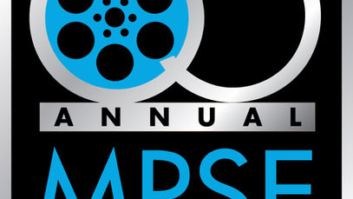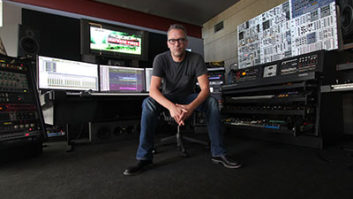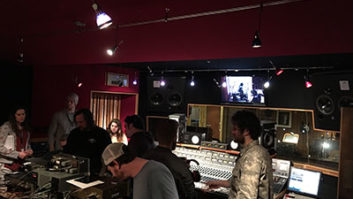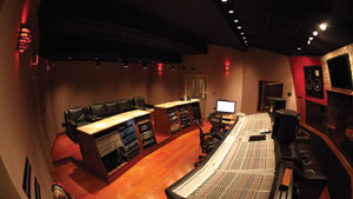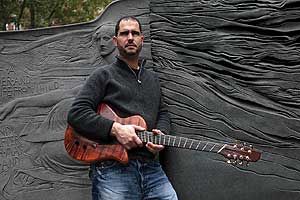
Charlie Hunter
Seventeen years down the line since the Charlie Hunter Trio’s eponymous debut album, no one is still wondering whether Hunter’s 8- and now 7-string guitar wizardry — which allows him to play bass and lead/rhythm guitar at once — is a gimmick. Yes, he really does pull off these multiple roles beautifully, but more importantly, Hunter has also shown himself to be a gifted composer and a wonderful collaborator — certainly one of the most interesting all-around guitarists working in jazz during the past two decades.
The good news is that Hunter continues to look for new ways to express himself. His fine new album — the title of which will bring shivers to anyone who has ever played in a band, Gentlemen, I Neglected to Inform You You Will Not be Getting Paid — finds the New York-based guitarist in a band setting unique to my experience: guitar, two trombones (Curtis Fowlkes and Alan Ferber), trumpet (Eric Biondo) and drums (Eric Kalb). “I wrote this music and really wanted to do it with brass,” Hunter explains. “In fact, I originally thought of using three trombones, but even for me that would be a bit much.” What’s the appeal of writing for trombones? “It’s an underutilized instrument,” he answers. “The saxophone became the pre-eminent instrument in the jazz idiom, and the emphasis has been on bop-ish solos with lots of notes and lots of changes and lots of velocity — very dense. But the thing the trombone does, which is really cool in terms of the kind of music I want to write and play, is it has this intensely vocal quality. It has the ability to have a lot of different sounds, not just dependent on the [ability of the] person who’s playing it, but also with the different mute selections you can have. And rhythmically, it really sits in with the drums and my instrument and it can really punch. The way I tend to play music is more vertically improvised — it’s more about the rhythms and the rests where you fit in, and not a lot of flurries — and the trombone is a great foil for that.”
There’s definitely a New Orleans feel to some of this music — the trombone/trumpet combo will do that almost automatically — with languid ballads mixed with saucy funk numbers. As always, Hunter’s playing is tasteful and economical, but also adventurous: The spare arrangements still give him plenty of room in which to jam. This group had only rehearsed some and played one gig together when they went into Brooklyn Recording to cut this album, so the tracks seem fresh and alive, as if the players are just discovering the magic in the quintet. It’s a bare-bones, no-frills recording, but that, too, is part of the disc’s charm. It is simple by design.
“Charlie was looking to make an inexpensive album,” comments Dave McNair, who engineered and mixed the album, “so I proposed the ultimate mix budget: ‘Why don’t you record it live to 2-track?’ He said, ‘Dude, can we do that?’ I said, ‘We can definitely do that. Let me record it and I’ll be mixing it while we record it. But you’re going to have to go to a nice studio because you can’t go to any old place. It’s gotta sound really good in the room we use.’” McNair, whose main gig is mastering at Sterling Sound, doesn’t do much music tracking these days, but certainly is accomplished in that area.
But the next decision the pair made was perhaps more unconventional than live-to-2-track. “I went over to Charlie’s house [they both live in Montclair, N.J.] and sat in his practice room and he played me some of the tunes so I could conceptualize it,” McNair says. “I heard the melodies and he told me how he thought the groove should be, and I started to picture how it should sound [with the group] in my head. And then he said, ‘I’d kind of like a lo-fi thing; I don’t want it to be too shiny.’ Okay, fine, I have no problem with that. ‘In fact, I want it to be mono.’ I said, ‘Really? Mono? Can we at least spread a little ambience or something?’ He said, ‘Yeah, that’s cool, but I really want everything to be in the middle. It really screws with the groove if you’ve got stuff spread out.’”
Hunter elaborates, “I’ve always liked mono, and the majority of records I listen to are mono. All those great old records that came out on Specialty and Blue Note, plus the early soul and R&B — that was all mono and it’s very powerful and rhythmically very punchy. It’s centered-sounding, not diffuse. In listening on headphones, I thought a lot of the pocket was getting lost by the pan happening and the time delay from side to side [in stereo recordings]. I thought, ‘Wouldn’t it be perfect to make something that didn’t have that — that was hitting you all at once?’”
McNair: “So the record is actually mono except for the return from an EMT plate and then just a hair — a tiny bit — of a pair of East German Neumanns we used as room mics.”
Miking on the instruments was also kept simple. “I only used three mics on the drums,” McNair says. “A [Neumann] 47 on the overhead; a 47 kind of behind the floor toms — almost like a Glyn Johns thing, but maybe a little higher than that, looking at the floor tom and the ride cymbal — and then an M49 about two feet from the bass drum, no hole. No snare mic, no hi-hat mic, no tom mics.” The two trombones “each played into either side of an RCA 44 ribbon; the trumpet was a Coles [ribbon].”
As for Hunter’s custom Jeff Traugott 7-string axe — which has three bass strings and then four strings, “like the middle four strings on a regular guitar,” he says — that constitutes two channels. McNair explains, “He’s got a pickup on it so the bottom three strings go to a separate output and it’s pretty discrete — you can hear a tiny bit of guitar in it but not much.
“[The bass signal] went to an Ampeg SVT, just used as a head, and powered [to] a closed single cabinet — it’s a box with a speaker in it and you put the mic in there. I think I had a condenser — maybe a TLM 170 — in there. No direct; just the mic on the internal cabinet, no EQ. Then the guitar signal went to Charlie’s [Wayne Jones/Headstrong blueprinted Fender] Deluxe, and I put an RCA 44 ribbon on that. The only other mics were the room mics, which were spaced on either side of the control room window.”
All mics went straight into Brooklyn’s Steve Firlotte/Inward Connections-designed 10-channel Vac Rac re-creations of Bill Putnam’s United Western tube preamps, “no EQ whatsoever,” McNair says. “Then we took the output of the rotary fader and put [it] into the cleanest insert point in the Neve so I could have faders in front of me, and I put a Pendulum Audio Variable-Mu 6386 — a little bit of that — on the quasi-stereo, and that was it; no compressor on the bass, guitar, horns. I put a little bit of a Purple Audio 1176 on the 47 overhead and that was it. Then we went to 15 ips [Ampex ATR-102] half-inch, no noise reduction.”
Recording took place on two different days: The first was devoted to setup and capturing a couple of songs that feature just Hunter and drummer Kalb; the second was the full quintet. There are no overdubs at all on the album, and even McNair’s original notion of comping together performances at convenient edit points from different takes went out the window (except for the title track, which comes from two takes). “It was all so well-played it just became a question of which performance was the best,” McNair says.
Hunter says he was happy to leave the take selection to McNair, noting, “Once I play it, I trust it to others to know what to do with it. Dave’s very musical, so I had no trouble putting it in his hands.”
And as for the mono(ish) 2-track experiment? “I liked it,” Hunter says. “I can definitely picture doing that again.”



